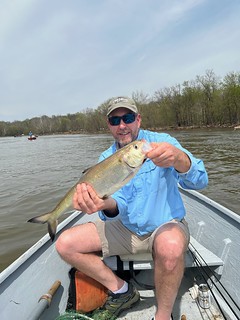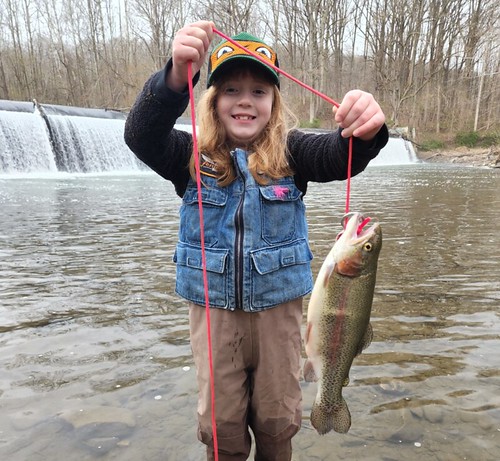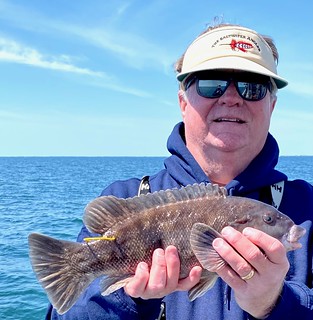Maryland Fishing Report – April 20
Chillier weather descended upon Maryland this past week, and areas of Western Maryland even received a significant amount of snow. Warmer weather is in the forecast ahead, just in time for a weekend of fishing together with family and friends. This month offers special opportunities for our younger anglers to enjoy fishing in the put-and-take trout fishing waters, which are being stocked each week.
Forecast Summary: April 20 – April 26:
Cool, wet weather recently dropped water temperatures, but warm weather in the next week will quickly warm Maryland waters for gamefish such as striped bass and white perch, or the shad run the next couple of weeks in lower salinity waters. Chesapeake Bay surface water temperatures have dropped several degrees since last week to the low 50s. After several days of this week’s warming temperatures, smaller streams and downwind areas on a sunny day will warm faster and hold water temperatures in the upper 50s.
Expect average flows for most Maryland rivers and streams this week. Expect below average water clarity from recent heavy rains for most of the main Bay down to Tolchester, as well as many rivers and streams. In addition, expect reduced water clarity from algal blooms in the Bush, Gunpowder, Back, upper Chester, Nanticoke, and middle Potomac River from the Route 301 bridge down to Leonardtown. To see the latest water clarity conditions, check Eyes on the Bay Satellite Maps on the Maryland Department of Natural Resources website.
There will be above average tidal currents Wednesday and Thursday as a result of the April 16-17 full moon.
As always, best fishing areas could be further refined by intersecting them with underwater points, hard bottom, drop-offs, and large schools of baitfish.
For more detailed and up-to-date fishing conditions in your area of the Bay, be sure to check out Eyes on the Bay’s Click Before You Cast.
Anglers will most likely see stained water conditions and above average flows from the Conowingo Dam from recent rain and snow in the upper Susquehanna watershed. Late last week the hickory shad made a run up Deer Creek when water temperatures in the creek spiked at 68 degrees. Unfortunately a cold front has moved in on Monday and has caused the hickory shad to retreat back into the Susquehanna. The same holds true for Octoraro Creek. A predicted warming trend this weekend may be the next chance for improvement to this catch-and-release fishery.

Jiro Akiyama and Bao Nguyen found a great place to fish for blue catfish off the beach at Sandy Point State Park, and by the look of things they could use a bigger ice chest. Photo by Erik Zlokovitz
Brightly colored shad darts and small flashy spoons are popular lures to cast, often in tandem. Shad darts of various weights in red and white, yellow, gold, pink, or chartreuse are good to have in your tackle box, along with small gold and silver spoons.
White perch are holding in the lower Susquehanna River but with cloudy water they have been difficult to catch. Casting small jigs is often a popular way to catch them, but with current conditions fishing with bait may be a better choice. Grass shrimp or pieces of bloodworm on a bottom rig is the common choice.
Fishing for blue catfish is a big draw in the upper Bay, where salinity values are traditionally low during the spring months, so the blue catfish are free to roam the entire region. Many large-sized blue catfish are being caught from the Susquehanna River to the Bay Bridge. The catfish can also be found in every tidal river to some degree. Cut menhaden or gizzard shad are perhaps the two top choices for baits, but other baits will work. A circle hook from 5/0 to 7/0 works well on a sliding sinker rig and will also allow a quick-and-easy release if a striped bass is caught by accident. One does not need a boat to fish for blue catfish; there are many access points in the upper Bay, and the DNR angler access map can help you find a shoreline access point to fish.
The Maryland Department of Natural Resources has several volunteer angler surveys where biologists seek to learn more about what Maryland anglers are catching and releasing. There are surveys for striped bass, American shad, the Maryland Artificial Reef Initiative, Potomac River smallmouth bass, and freshwater species. Find where to enter your information on the DNR Fishing and Boating Services website. The data from last year’s striped bass survey is also available online.
Most of the fishing action in the middle Bay is taking place in the tidal rivers. A mix of white perch, blue catfish, channel catfish, and hickory shad are providing some action. Water temperatures took a nosedive with the recent lingering cold front, but salinity values in the Bay are low due to typical spring runoff, attracting a mix of blue and channel catfish.
Blue catfish and channel catfish are being caught in the tidal rivers and in the Bay by those soaking cut bait of menhaden, gizzard shad, or alternative baits. There tends to be good fishing from shore for these species of catfish, so it is a great way to fish when the wind is blowing. The use of circle hooks is advised, as it makes fishing for the catfish easier and also beneficial for ease of dehooking for any fish that is to be released, such as striped bass.
The white perch are making their way down the tidal rivers that have spawning populations. On the Choptank River they can be found from Denton to the town of Choptank, with the larger perch at the most southern extent of their travels. Fishing with grass shrimp and pieces of bloodworm on a bottom rig is the most popular way to fish for them at this time, especially when fishing from shore.
Anglers have been enjoying fun catch-and-release fishing for hickory shad in the upper Choptank from Greensboro to Red Bridges for the past two weeks. The cold front has caused water temperatures to drop, and the activity of the hickory shad is expected to slow down until sunny weather brings water temperatures back up later this week. Small shad darts and spoons in various colors are the lures being used.

John Lipetz is all smiles with this American shad before slipping it back into the Potomac. Photo by John Kuriawa
The hickory shad and American shad run at the upper end of the tidal Potomac River in the Fletcher’s Boathouse area provide plenty of fun catch-and-release action. The waters are cloudy due to the recent rain, and snowmelt from the upper Potomac will most likely raise water levels by the weekend. Be careful If you venture out this weekend to explore the fishing possibilities. When water temperatures and water clarity are conducive to fishing, the action can be very good, and it’s one of the best places to try and tangle with an American shad.
White perch are being found in the lower sections of the region’s tidal creeks and the middle to upper sections of the tidal rivers. Most of the white perch in the rivers are running deep, so a bottom rig baited with grass shrimp or pieces of bloodworm are one of the best ways to fish for them, especially from shore. If you’re in a boat, you can try jigging small jigs tipped with pieces of bloodworm or minnow. In the shallower creeks, casting small jigs and beetle spins can work.
Northern snakeheads are responding to warmer water temperatures and becoming more active by day, when warm weather and sunny conditions prevail. The cold front that moved in temporarily put the skids on northern snakehead fishing but those who persist continue to catch them. On sunny afternoons, the shallow waters on the sunny side of creeks is a great place to cast paddle tails and frogs. Dead-sticking a large minnow under a bobber somewhere nearby in deeper water can also pay off while you’re casting, just keep a watchful eye on it. The tidal creeks of Dorchester County, the lower Eastern Shore’s rivers, the Patuxent and Potomac rivers, and their tributaries also hold a lot of northern snakeheads.
Fishing for blue catfish is the main focus of many anglers this week in the Potomac, Patuxent and Nanticoke rivers. There are a lot of very large blue catfish being caught by anglers fishing from shore or from boats. Cut menhaden and gizzard top the list for baits for these large cats. Many anglers also have good luck with chicken liver, chicken breast meat, clam snouts, and scented baits. A 5/0 to 7/0 circle hook is the hook of choice when fishing with the larger baits. The Wilson Bridge-Fort Washington area is one of the better places to fish on the Potomac. The Benedict Bridge to Jug Bay on the Patuxent is full of blue catfish, and the Sharptown area on the Nanticoke is an excellent place to fish.

Greyson Punsala gives his best Jimmy Houston impression by giving his trout a kiss. Photo by Wiljohn Punsala
April is a big month for put-and-take trout anglers, as water temperatures are conducive to trout stockings in marginal waters such as community ponds in the central and southern regions. The hatchery crews are out stocking trout every day during the week, so keep watch on the trout stocking website.
Anglers at Deep Creek Lake report that water temperatures are much cooler than this same time last year. Largemouth bass may be a little sluggish and holding deep, but walleye, smallmouth bass, and yellow perch do not mind the cooler water and are providing good fishing opportunities.
The Maryland Department of Natural Resources is conducting a new survey to track and understand the walleye fishery at Deep Creek Lake. Staff biologists have tagged 450 walleyes with yellow tags along the soft dorsal fin on the left side of the fish. Anglers who catch a tagged fish are asked to report the catch to DNR by calling the number on the tag and reporting the date and location of catch, tag number, and whether walleye was kept or released. Any angler who reports tagged walleye this year will be entered into a drawing for a $50 prepaid Visa gift card. Anyone with questions or comments about the walleye tagging project or the walleye fishery in Deep Creek Lake can call 301-334-8218 or email matt.sell@maryland.gov.
The upper Potomac River water levels are up as melting snow from Monday’s storm works its way down feeder creeks to the river. High water and stained conditions may persist till the end of the week, but may clear up by the weekend. Catch-and-release fishing for smallmouth bass will return once the river calms down.
Fishing for largemouth bass is very good in many areas of the central, southern and eastern regions. The male largemouth bass are moving into spawning areas and carving out nests. The larger female largemouth bass tend to be holding in transition areas between the spawning shallows and the deep water. A variety of lures can work well in the transition areas, including jerkbaits, lipless crankbaits, soft craw baits, spinnerbaits, blade jigs, and soft plastics. In the shallows, creature soft plastics can be a good choice. As a reminder, fishing for largemouth bass in nontidal waters is catch-and-release only until June 15. Tidal waters are open to possession with a minimum size of 15 inches until June 15, and 12 inches for the rest of the year.
Springtime crappie fishing could hardly be any better in the many nontidal and tidal waters around the state. The larger crappie tend to be holding near any kind of structure they can find, and casting small marabou jigs or soft plastics is a great way to fish for them. The traditional minnow under a slip bobber is not to be overlooked.
Despite some rather pesky wind and cooler weather, surfcasters fishing the beaches are catching some impressive numbers of black drum. Sand fleas tend to be the most popular bait and can readily be found on the spot with a simple bait scoop rake. Clearnose skates are a big part of the action and will keep anglers busy releasing them and adding new bait.
Black drum offer a rather different type of table fare. The medium-sized ones can be challenging to filet. The point of the knife is inserted under the skin and worked up for the cuts along the back. The scales on a medium-sized black drum are thick and tough, while those on a large black drum are more like silver dollars and just as thick. Depending on the size of the drum, the filets once skinned are often steaked. The meat is a bit different than most fish and is a solid white meat. Many anglers like to marinate it and grill the steaks. On a large black drum in the neighborhood of 80 pounds or better, the section of the filet from the anus rearward is often impacted with worms and is discarded.
Inside the Ocean City Inlet and near the Route 50 Bridge, surrounding bulkheads, and docks, tautog are being caught by anglers fishing with sand fleas. The throwback ratio can be high at times but most anglers are able to take a few legal fish home.
Striped bass are offering some fun catch-and-release fishing at the inlet, the Route 50 Bridge area, the Verrazano Bridge, and the Route 90 Bridge. Most anglers are having fun casting a variety of soft plastic jigs and paddle tails. Every once and a while a striped bass will measure over the minimum size of 28 inches and is sure to bring smiles.
Flounder are moving through the inlet and spreading throughout the back bay waters. The channels leading from the inlet have been a great place to fish with Gulp baits or traditional minnow baits. Recent winds have stirred up the bays reducing water clarity, so flounder fishing will suffer until the waters clear up. The recreational flounder regulations for the 2022 season are four flounder per day with a minimum size of 16 inches.
Tautog fishing has been very good out at the offshore wreck and reef sites, when wind conditions are favorable for boats to head out of the inlet. Anglers have been tagging tautog on a regular basis this season to gain valuable information about this fishery. If you catch a tagged fish be sure to write down the tag number and get a length, location and date if you choose to release the fish.
The 2022 black sea bass season will open May 15 and run to December 11. The daily creel limit will be 15 sea bass per day for each angler with a minimum size of 13 inches.
“There is only one theory about angling in which I have perfect confidence, and this is that the two words least appropriate to any statement about it are the words ‘always’ and ‘never.’” – Lord Edward Grey
Maryland Fishing Report is written and compiled by Keith Lockwood, fisheries biologist with the Maryland Department of Natural Resources.
Click Before You Cast is written by Tidewater Ecosystem Assessment Director Tom Parham.
This report is now available on your Amazon Echo device — just ask Alexa to “open Maryland Fishing Report.”



 1-888-373-7888
1-888-373-7888 233733
233733